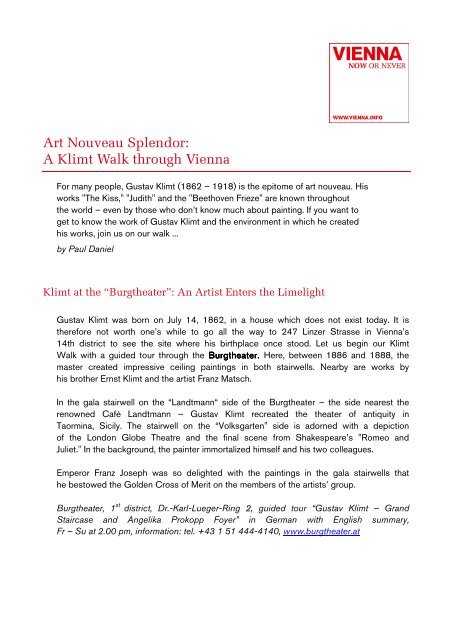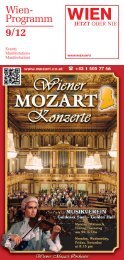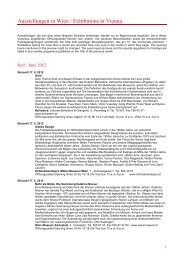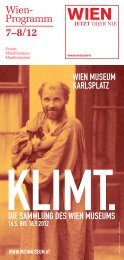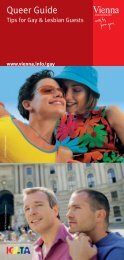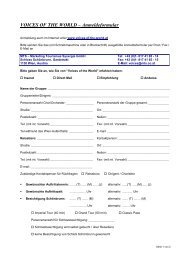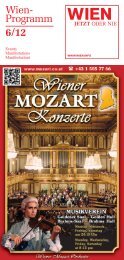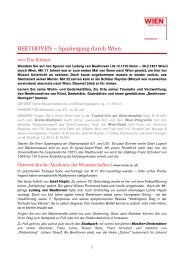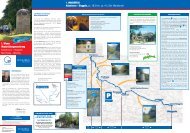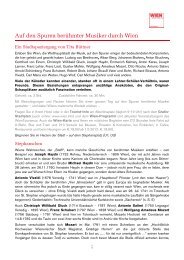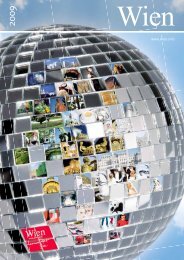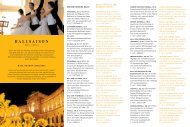Art Nouveau Splendor: A Klimt Walk through Vienna
Art Nouveau Splendor: A Klimt Walk through Vienna
Art Nouveau Splendor: A Klimt Walk through Vienna
You also want an ePaper? Increase the reach of your titles
YUMPU automatically turns print PDFs into web optimized ePapers that Google loves.
<strong>Art</strong> <strong>Nouveau</strong> <strong>Splendor</strong>:<br />
A <strong>Klimt</strong> <strong>Walk</strong> <strong>through</strong> <strong>Vienna</strong><br />
For many people, Gustav <strong>Klimt</strong> (1862 – 1918) is the epitome of art nouveau. His<br />
works "The Kiss," "Judith" and the "Beethoven Frieze" are known <strong>through</strong>out<br />
the world – even by those who don’t know much about painting. If you want to<br />
get to know the work of Gustav <strong>Klimt</strong> and the environment in which he created<br />
his works, join us on our walk ...<br />
by Paul Daniel<br />
<strong>Klimt</strong> at the “Burgtheater”: An <strong>Art</strong>ist Enters the Limelight<br />
Gustav <strong>Klimt</strong> was born on July 14, 1862, in a house which does not exist today. It is<br />
therefore not worth one’s while to go all the way to 247 Linzer Strasse in <strong>Vienna</strong>’s<br />
14th district to see the site where his birthplace once stood. Let us begin our <strong>Klimt</strong><br />
<strong>Walk</strong> with a guided tour <strong>through</strong> the Burgtheater.<br />
Burgtheater. Here, between 1886 and 1888, the<br />
master created impressive ceiling paintings in both stairwells. Nearby are works by<br />
his brother Ernst <strong>Klimt</strong> and the artist Franz Matsch.<br />
In the gala stairwell on the “Landtmann“ side of the Burgtheater – the side nearest the<br />
renowned Café Landtmann – Gustav <strong>Klimt</strong> recreated the theater of antiquity in<br />
Taormina, Sicily. The stairwell on the “Volksgarten" side is adorned with a depiction<br />
of the London Globe Theatre and the final scene from Shakespeare’s "Romeo and<br />
Juliet." In the background, the painter immortalized himself and his two colleagues.<br />
Emperor Franz Joseph was so delighted with the paintings in the gala stairwells that<br />
he bestowed the Golden Cross of Merit on the members of the artists’ group.<br />
Burgtheater, 1 st district, Dr.-Karl-Lueger-Ring 2, guided tour “Gustav <strong>Klimt</strong> – Grand<br />
Staircase and Angelika Prokopp Foyer” in German with English summary,<br />
Fr – Su at 2.00 pm, information: tel. +43 1 51 444-4140, www.burgtheater.at
Along the Ring Boulevard to the Museum of Fine <strong>Art</strong>s:<br />
A View of the “Show Window” of the Habsburg Monarchy<br />
The Museum of Fine <strong>Art</strong>s (Kunsthistorisches Museum) which boasts, among other artworks,<br />
the largest collection of Bruegel paintings worldwide, is considered one of the most<br />
important museums in the world. Here, Gustav <strong>Klimt</strong> created 40 spandrel and<br />
intercolumnia paintings (Zwickel- und Intercolummnibilder) in 1891 with his artist<br />
colleagues; they worked on those areas that remained free between arches and columns in<br />
the splendid stairwell of the museum.<br />
Here, the three painters depicted the main epochs of art history with symbolic figures.<br />
An information tablet set into a small table on the balustrade of the stairwell explains<br />
the meaning of these figures. This was the last important work by the artists’ group.<br />
After the death of his brother Ernst in 1892, <strong>Klimt</strong> ended his cooperation with Matsch.<br />
Museum of Fine <strong>Art</strong>s (Kunsthistorisches Museum), 1 st<br />
district, Maria-Theresien-Platz,<br />
Tel. +43 1 525 24-0, www.khm.at, Tue – Sun 10:00 am – 6:00 pm,<br />
Thu 10:00 am – 9:00 pm [discount [discount [discount with with the the <strong>Vienna</strong> <strong>Vienna</strong> Card]<br />
Card]<br />
Café Gerstner at the Museum of Fine <strong>Art</strong>s, Tue - Sun 10:00 am - 5:00 pm,<br />
www.gerstner.at<br />
The Leopold Museum: Gustav <strong>Klimt</strong> and His Contemporaries<br />
The MuseumsQuartier <strong>Vienna</strong>, opened in 2001 counts among the ten largest cultural<br />
complexes in the world. At the Leopold Museum, in addition to the important Schiele<br />
Collection, one also finds main works by Gustav <strong>Klimt</strong> – among others, his famous<br />
painting "Death and Life" as well as the landscapes "A Morning at the Pond” and “<br />
Attersee.” The museum also shows fascinating works by Oskar Kokoschka, Richard<br />
Gerstl, Albin Egger-Lienz, Anton Kolig, Herbert Boeckl and Alfred Kubin. Before<br />
continuing to the next fascinating <strong>Klimt</strong> sight, you can take coffee or refreshments at<br />
the "Café Leopold" in the museum.<br />
Leopold Museum: 7 th district, Museumsplatz 1, Tel. +43 1 525 70-0,<br />
www.leopoldmuseum.org, Wed – Mon 10 am – 6 pm, Thu 10 am – 9 pm<br />
[discount [discount [discount with with the the <strong>Vienna</strong> <strong>Vienna</strong> Card]<br />
Card]<br />
Café Leopold: Tel. +43 1 523 67 32, Sun – Wed 10:00 am – 2:00 am,<br />
Thu – Sat until 4:00 am www.cafe-leopold.at<br />
<strong>Klimt</strong> meets Ludwig: The Monumental Beethoven Frieze<br />
In 1902, <strong>Klimt</strong> created one of his most famous works, the Beethoven Frieze, for an<br />
exhibition of the Secession movement. The entire show was an homage to Ludwig<br />
van Beethoven. <strong>Klimt</strong>’s monumental frieze greeted visitors in the entrance hall.<br />
Thirty-four meters wide and two meters high is this opulent, ornamental “symphony,”
in which <strong>Klimt</strong> sought to immortalize Beethoven’s “Ninth“ and its interpretation by<br />
Richard Wagner.<br />
Not only contemporaries were deeply impressed by this work – the world at large is<br />
still showing its appreciation. Originally, the cycle was intended to be dismantled<br />
once the exhibition had ended. A collector bought the frieze in 1903 and removed it<br />
from the wall, separating it into seven pieces. In 1973, the Republic of Austria bought<br />
the valuable work and made it accessible to the public in 1986 in a room specially<br />
created for it in the Secession.<br />
As was the case during <strong>Klimt</strong>’s time, the Secession building is still devoted to<br />
contemporary art in changing exhibitions, which can be viewed during guided tours<br />
(also in conjunction with the Beethoven Frieze). At the Museum Shop, you can<br />
acquire attractive reproductions of details from the frieze as well as books about<br />
Gustav <strong>Klimt</strong>.<br />
Secession, 1 st district, Friedrichstrasse 12, Tel. +43 1 587 53 07, www.secession.at,<br />
Tue – Sun 10:00 am – 6:00 pm, Thu 10:00 am – 8:00 pm, guided tours Sat 3:00 pm,<br />
Sun 11:00 am and by arrangement<br />
<strong>Art</strong> in Passing: Karlsplatz<br />
Some of the sights around Karlsplatz Karlsplatz are directly or indirectly connected to Gustav<br />
<strong>Klimt</strong>. One splendid example is the Stadtbahn Stadtbahn Pavilion Pavilion, Pavilion that architect Otto Wagner built<br />
around 1900 for the <strong>Vienna</strong> <strong>Vienna</strong> City City Rail Rail, Rail and where all elements can be found again<br />
which you have already encountered elsewhere in the footsteps of Gustav <strong>Klimt</strong>:<br />
floral ornaments, gold decoration, and attention to the smallest details. Or<br />
Künstlerhaus<br />
Künstlerhaus, Künstlerhaus that institution that Gustav <strong>Klimt</strong> and his friends turned their backs on.<br />
And the <strong>Vienna</strong> <strong>Vienna</strong> <strong>Vienna</strong> Museum Museum Karlsplatz Karlsplatz (the former Historic Museum of the City of<br />
<strong>Vienna</strong>), which houses some important works by Gustav <strong>Klimt</strong>, among them the<br />
paintings "Emilie Flöge," "Pallas Athene" and the early work "Interior of the<br />
Burgtheater" (1887).<br />
Otto-Wagner Stadtbahn Pavilion, 1 st district, Karlsplatz, Tel. +43 1 505 87 47-85177,<br />
April to Oct.: Tue – Sun and pub hols., 10:00 am-6:00 pm, www.wienmuseum.at<br />
Künstlerhaus, 1 st district, Karlsplatz 5, Tel. +43 1 587 96 63, www.k-haus.at,<br />
Tue – Sun 10:00 am – 6:00 pm and Thu 10:00 – 9:00 pm [discount [discount with with with the the the <strong>Vienna</strong> <strong>Vienna</strong> <strong>Vienna</strong> Card]<br />
Card]<br />
<strong>Vienna</strong> Museum Karlsplatz , 4 th district, Karlsplatz, Tel. +43 1 505 87 47-0,<br />
www.wienmuseum.at, Tue – Sun and pub hols 10:00 am - 6:00 pm<br />
[discount [discount with with the the the <strong>Vienna</strong> <strong>Vienna</strong> Card]<br />
Card]
Apprenticeship of a Genius: The MAK and Gustav <strong>Klimt</strong><br />
At the Austrian Museum for Applied <strong>Art</strong>s (MAK), Gustav <strong>Klimt</strong> learned his trade from<br />
1876 to 1883 with the decoration painter Ferdinand Laufberger. Hans Makart, the<br />
most important painter of the <strong>Vienna</strong> Ringstrassen Era, invited the student <strong>Klimt</strong> in<br />
1879 to participate in the legendary gala parade on the occasion of the silver<br />
anniversary of Emperor Franz Joseph and his wife Elisabeth (“Sissi”).<br />
Today, one can see nine wonderful design sketches, created by Gustav <strong>Klimt</strong> from<br />
1905 to 1909 for the mosaic frieze at the Brussels Palais Stoclet. The Palais Stoclet<br />
is considered the most important work by the art nouveau architect Josef Hoffmann.<br />
Together with a number of Viennese art nouveau artists and craftsmen of the Wiener<br />
Werkstätte, Hoffmann created this unique work of art from 1905 to 1911 as a<br />
commission by Adolphe Stoclet.<br />
The MAK provides fascinating insights into the wealth of ideas and forms as well as the<br />
esthetic power of Viennese art nouveau and <strong>Art</strong> Deco. Since 1955, the museum<br />
has owned the archives of the Wiener Werkstätte and continuously exhibits furniture, metal<br />
and leather works, fashion and tapestries, books, ceramics, glass as well as<br />
objects of daily life by such artists as Adolf Loos, Josef Hoffmann, Koloman Moser and<br />
Dagobert Peche. At the MAK Shop, you can buy decorative reproductions of <strong>Klimt</strong>’s<br />
sketches for the Stoclet Frieze.<br />
MAK – Austrian Museum for Applied <strong>Art</strong>s, Contemporary <strong>Art</strong>, 1 st<br />
district, Stubenring 5,<br />
Tel. +43 1 711 36-0, www.mak.at, Tue 10:00 am – midnight,<br />
Wed – Sun 10:00 am – 6:00 pm [discount [discount with with the the <strong>Vienna</strong> <strong>Vienna</strong> Card]<br />
Card]<br />
A Kiss makes History: <strong>Klimt</strong> at the Austrian Gallery Belvedere<br />
Here, the most famous painting of the master is on view: "The Kiss," this icon<br />
measuring 180 by 180 centimeters, whose ornamental character was enhanced by<br />
<strong>Klimt</strong> with gold and silver.<br />
According to a contemporary rumor, the couple depicted in “The Kiss” are the artist<br />
himself and his lifelong partner Emilie Flöge, whose fashion salon was designed by<br />
Gustav <strong>Klimt</strong> and Kolo Moser.<br />
<strong>Klimt</strong>’s patronage and some paintings in which he depicted his lover not only secured<br />
Madame Flöge a place in Viennese society, but also a permanent place in art history.<br />
His relationship to Emilie did not prevent the master, however, from starting affairs<br />
with some of his models.<br />
With “The Kiss,” which was bought in 1908 by the Moderne Galerie, <strong>Klimt</strong> reached<br />
the pinnacle of his “golden” phase. An additional famous work of this period, "Judith I,"
is also exhibited at the Austrian Gallery, as is the "Lady with Hat and Boa," the<br />
painting “Johanna Staude” and a multitude of fascinating landscape paintings. These<br />
are mainly of the Attersee and its environs, the Upper Austrian Salzkammergut,<br />
where <strong>Klimt</strong> spent nearly every summer after 1900.<br />
Gustav <strong>Klimt</strong> died on February 6, 1918 after a stroke. The master of ornaments and painter<br />
of alluring women was interred in an honorary tomb at the Hietzing Cemetery<br />
(13 th district, Maxingstrasse 15, underground line: U4, Bus: 56 B; the tomb is in<br />
Group V/194/195).<br />
A Palace for <strong>Art</strong>: The Belvedere<br />
The Belvedere was built in 1721-22 by Johann Lukas von Hildebrandt as the summer<br />
residence for Prince Eugene of Savoy and is considered one of the most beautiful Baroque<br />
buildings in the world. In its beginnings, the Paintings Gallery which is<br />
housed in the palace, the former "Austrian Gallery," was supported in great measure<br />
by the <strong>Vienna</strong> Secession and thus by Gustav <strong>Klimt</strong>. Here, you will not only find the<br />
largest collection of works by Gustav <strong>Klimt</strong>, but also masterworks by Egon Schiele<br />
and Oskar Kokoschka. Also, important works of the French Impressionism, the most<br />
important Biedermeier collection as well as highlights of the Baroque and Medieval<br />
Collection are accommodated here.<br />
Today, there are special exhibitions in the Lower Belvedere and its Orangerie; one<br />
can also view the gala rooms. The museum itself has long been moved to the Upper<br />
Belvedere on the other end of the splendid garden and has become an important<br />
center for admirers of <strong>Klimt</strong> from all over the world.<br />
Austrian Gallery Belvedere, 4 th<br />
district, Prinz-Eugen-Strasse 27, Tel. +43 1 79 557-0,<br />
www.belvedere.at, daily 10:00 am – 6:00 pm [discount [discount with with the the the <strong>Vienna</strong> <strong>Vienna</strong> Card]<br />
Card]<br />
Paul Daniel is a public relations consultant and journalist and lives in <strong>Vienna</strong>.


